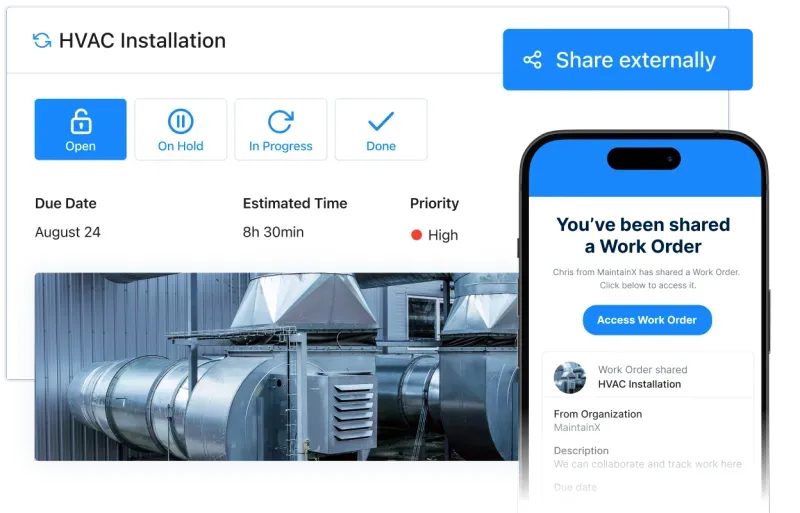
Seventy-four acres—that’s the size of the average golf course.
Unlike other popular sports, golf doesn’t require any two competition areas to be exactly the same. In fact, part of the fun of playing golf is experiencing new and different courses.
Despite their love-hate relationship with the game—usually dependent on daily performance—the 24 million individuals that play golf in the United States of America can probably agree on one thing: the therapeutic effect of a well-maintained golf course. What many players don’t realize?
Golf course maintenance is more complicated than mowing a lawn and turning on the sprinklers at night. In this guide, we’ll review important aspects of golf course maintenance, the chemicals greenskeepers use to treat turf, and the risks of falling behind on preventive maintenance (PM) tasks. We’ll begin by defining golf course maintenance.
What Is Golf Course Maintenance?
Golf course maintenance refers to maintenance activities done to keep course resources in good working condition. It includes repairing and replacing club assets, mowing and chemically treating turf, eliminating ball marks, improving playing conditions, and more. Behind the scenes of every clubhouse are workers inspecting irrigation systems, checking the water quality, and maintaining golf carts.
How Do You Maintain a Golf Course?
1. Remove Ball Marks
One of the highest priorities for every country club is removing ball marks every day. When golf balls fall from the sky, they make depression marks on the turf. In turn, these marks make the putting green uneven. Consequently, golfers find themselves misdirecting their putts.
Predictable slope, speed, and putting surfaces are crucial to good golf games. Golf superintendents should assign a staff member to inspect each green with a “ball mark repair tool” to remove all visible marks. This is one of the simplest golf course maintenance activities guaranteed to keep members happy.
2. Prioritize “The Big Three”
Research shows golfers most prioritize firm fairways and fast greens when evaluating courses. For this reason, golf superintendents must prioritize maintenance routines for “The Big Three.” According to USGA, the recipe for putting green perception includes three factors: Firm, Slope, and Speed.
- Firm putting greens ensure balls move far from where they land.
- Fast putting greens allow balls to roll freely.
- Slopes, or gradients, allow for challenging levels of play.
The USGA recommends maintaining firmness, speed, and slope with three tools: a Stimpmeter, TruFirm, and a digital level.
3. Rake Bunkers
Bunkers test a golfer’s ability to either play in the sand or avoid hitting the sand. They represent a temporary handicap to be overcome with skill, determination, and luck. More than 52 percent of players say high-quality bunkers are essential to a positive golfing experience.
Tips to Maintain Bunkers:
- Create multiple access points for motorized rakes for each bunker.
- Ensure bunkers have a proper drainage system and no water from other areas can enter them.
- Rake bunkers daily to remove footprints and level the sand.
- Keep sand depth in the bunker between 4-6 inches.
- Regularly mow the turf around bunker edges.
- Follow USGA standards for golf course design, construction, and maintenance.
4. Repair Divots
It happens by accident—players sometimes cut turf during golf strokes or by shuffling their feet. Of course, the daily damage caused by divots will depend on the number of club members and the course size. Low-traffic courses don’t see frequent divot damage, while heavily-used courses need more daily repairs.
Maintenance teams must routinely repair them because damaged turf makes players unhappy. Not only are divots ugly, but they can ruin an otherwise good game! The most critical divots to fix are those located in the primary field of play: the tee box, the fairway, and the greens.
5. Involve Players in Maintenance
Most players visit golf courses to improve their game and have fun. However, they can also contribute to the golf course’s maintenance for the good of all.
Club members can lighten the maintenance burden by keeping carts on assigned paths, raking sand traps, and fixing noticeable ball marks. You can encourage players to “do their part” by hanging signs, issuing member policies, and rewarding helpful behavior when you see it.
6. Practice Golf Cart Preventive Maintenance
Maintaining immaculate turf doesn’t mean much without reliable vehicles. Golf cart repair and maintenance are essential for providing players with enjoyable club experiences. If you’re using electric golf carts, aim to inspect them every week.
PM Tasks for Golf Carts
- Wash carts daily.
- Ensure golf carts are fully charged daily.
- Recharge batteries regularly.
- Check tire pressure regularly.
- Check for oil leakages regularly.
- Inspect water coolant levels daily.
- Repair carts in a timely fashion.
7. Adopt the “Triple ‘A’ Approach”
Most golf courses waste significant water trying to keep turfs healthy and green. Consider adopting the “Triple ‘A’ Approach” to conserve water usage. The method involves three steps: assessment, analysis, and action.
Managers should assess course climate conditions, analyze anticipated weather changes, and irrigate based on data. This plan helps golf course management adjust their irrigation schedules to conserve water while keeping turfs green.
8. Prioritize Golf Course Pest Control
As reported by Golf Course Industry Magazine, a critical issue faced by golf facilities in 2018 was “turf loss due to pests.” The most common culprits of unsightly turf loss include weeds, insects, and funguses. Albrecht Koppenhofer, a specialist in turfgrass insect pest management at Rutgers’ Department of Entomology, advises golf superintendents to follow a preventative approach to pest management.
Performing periodic chemical treatments reduces the likelihood of costly turf scarring caused by pests. Unfortunately, it’s not uncommon for budgetary constraints to prevent golf course superintendents from implementing ideal turf maintenance. The experts at the Ohio Turfgrass Foundation recommend maximizing maintenance budgets by:
- Focusing on your two most prevalent pest issues at a time.
- Creating a calendar to organize which types of pests to target each season.
- Calculating your turf’s unique nitrogen needs before seeking low-cost, effective nitrogen treatments (soil sampling and county agents can help with this task).
- Removing unnecessary trees, tees, and bunkers to refresh course designs instead of undergoing full-fledged renovations.
Now, let’s take a closer look at the chemicals involved in controlling pests.
What Chemicals Are Used to Maintain Golf Courses?
Golf superintendents use a variety of chemicals to keep away unwanted pests and weeds. Treatment substances, frequency, and methods will vary widely depending on golf course climate and location.
As Todd Lowe, a Green Section agronomist, mentions:
“You’re dealing with microclimates and unique ecosystems that demand different management programs,” he says. “We have golf courses in Florida that were built on old tomato fields or citrus groves that have wall-to-wall nematodes. On other courses, the problem might be on one green and a tee box.”
Put simply, familiarizing yourself with your golf course’s ecosystem—soil type, average weather conditions, local pests, and weeds—is essential to preventing and managing turf. Talk to other local course owners, county agents, and golf experts to learn more about your unique ecosystem.
Common Golf Course Maintenance Chemicals
Pre-Emergent Herbicides
Maintenance workers apply these solutions during fall and spring to prevent unwanted seed growth. Notably, pre-emergent herbicides don’t affect already established plants. Examples include Atrazine 4L, Barricade 4FL, and Dithiopyr 40 WSB.
Herbicides
In recent years, some golf courses have begun partnering with environmental experts to experiment with organic treatment options. The goal is to improve the public health and ecological footprint of greens and fairways. Unfortunately, going completely organic isn’t easy. In fact, it requires a much greater time commitment to routine soil monitoring.
Fungicides
Fungicides are chemicals used to kill or inhibit fungi and fungal spore growth. There are different types of fungicides, including contact fungicides such as Banol Fungicide, systemic fungicides like AzTeb Select, and phosphites such as Quali Phite F.
Insecticides
Golf maintenance teams use these chemicals to combat invasive pests that harm soil and turfs. Examples include Abamectin 0.15EC Select, Xentari (Lbs), and Avid + Heritage Multipak.
Growth Regulators
Golf course attendants must regularly aerate soils, measure pH/nutrient levels, and carefully water their lawns. Environmental practices are emphasized so that toxic and biologically based pesticides are used only as a last resort. As always, it’s essential to carefully research your options before determining what’s right for your individual facility, climate, and O&M budget.
Growth regulators suppress the growth of seedheads and leaves to minimize mowing costs and improve turf safety. They can enhance the overall quality of turf, enabling smooth and uniform playing surfaces. Examples include Agra-Rouse, Atrimmec, and Cutless 0.33% Granular.
Plant Stimulants (Hormones)
Plant stimulants enhance seed growth, flowering times, and plant shapes. They determine leaf formation, fruit development, the types of tissues that grow upwards or downwards, and plant longevity. Examples include Agra-Rouse and Pro-Gibb 4%.
These are post-emergent herbicides used to treat both broadleaf and grassy weeds. Golf superintendents often use them to spot-treat specific problem areas. Examples include 2-D Herbicide, Captain XTR Algaecide, and Aquanaut.
Risks of Falling Behind on Golf Course Maintenance
It’s essential for golf course management to periodically review and update its maintenance strategies to keep up with emerging situations. This enables management to focus servicing resources on the parts of the golf club that are integral to member satisfaction. Keeping up with golf course maintenance can be challenging. But performing little to no upkeep is worse. Consequences of failing to observe standard golf course maintenance practices include:
Ugly Grass
Unattended grass allows for the growth of moss, algae, and other unwanted pests. The longer the grass grows, the more difficult it becomes to return to ideal conditions. No more than one-third of the leaf blade should be mowed within a single mowing. Otherwise, you risk scalping the blades, which creates thin, brown patches of grass. Workers should mow greens at least twice per week.
Abandoned Fairways
Fairways can be grown longer than the greens but should still be mown at least once a week. Otherwise, the course will sport shaggier landing areas.
Costly Pests
Prepare your grass for the spring before it arrives. Materials that protect the grass from insects, weeds, and various diseases should be laid down in time. Without such protection, unwanted weeds and pests will invade the grass. It will require more resources to deal with the invasion than to prevent it.
Burnt-Out Grass
Like every other life form, golf course lawns depend on water for survival. The amount of water to use for irrigation depends on the turf type, climate, rainfall, and soil. The fairways and rough areas are more drought-tolerant compared to the greens. Without sufficient water, the grass is likely to burnout. In some cases, a complete rebuilding or replanting is needed to correct the situation.
Costly Weeds
When it comes to maintenance, especially on courses that are largely inactive, bunkers are often ignored. Weeds overtake abandoned bunkers, and while they’re easy to remove, it’s costly. The bunkers are also at risk of washouts, which can lead to the sand getting contaminated.
Neglected Amenities
In many courses, it’s common to find neglected ball washers, benches, drinking stations, and trash bins. Without maintaining these amenities, a golf course can pose a health risk to users.
How to Streamline Golf Course O&M
Diligent preventive maintenance plays a significant role in preserving golf course functionality. However, that doesn’t mean golf clubs don’t find themselves in reactive maintenance mode from time to time. Below are the best ways to simplify and streamline golf course operations and management.
1. Organize a Proactive Maintenance Program
With the support of a user-friendly Computerized Maintenance Management System (CMMS), organizing a proactive maintenance program is the easiest way to remove lawn care issues as an obstacle to facility success. A CMMS is a task management software that allows maintenance teams to coordinate preventive maintenance (PM) efforts in a centralized digital location. The apps remove the organizational problems associated with managing paper work orders, tracking asset histories, and maintaining staff accountability.

MaintainX allows operational managers to create, assign, and monitor recurring work orders for everything from pest control to landscaping duties. Golf maintenance technicians can then respond to work orders and message managers from the convenience of their smartphones. The best part?
2. Never Disrupt Tee Times
Golfers don’t like disruptions during play. Noise from mowers can ruin concentration and poorly timed maintenance activities can ruin play. For this reason, maintenance planners should strive to develop maintenance routines that systematically work alongside players without interference. Again, a user-friendly CMMS app can keep maintenance teams on the same page when assigning, monitoring, and completing tasks at ideal times.
3. Prioritize Sustainability
People enjoy golf because it’s played in a beautiful environment. Of course, beautiful and functional playing environments don’t “just happen.” Costly resources like water, fertilizers, and electricity keep facilities running smoothly.
Focus on protecting that environment while conserving resources. This includes using sustainable construction materials like solar power, stone walls, and thatched roofs that minimize environmental waste. Also, consider collecting and using rainwater for irrigation.
4. Source Durable Materials
Light fixtures, planters, and decorative features take hits from flying balls now and then. For this reason, it’s worthwhile to invest in durable materials for both original installations and replacement parts. Assets should be able to withstand harsh weather conditions so they don’t rot or rust quickly.
5. Prioritize Member Benefits
Nearly 63 percent of members report feeling happy with their golf club’s member benefits. Many benefits require routine maintenance and inspection checklists to execute as promised. Consider creating policies and standard operating procedures (SOPs) for the following:
Top-Rated Club Member Benefits:
- Simple booking processes
- Stocked locker rooms (e.g., mouthwash, shaving kits, and fresh towels)
- Stocked golf amenities (e.g., tees, filled sand bottles, golf carts)
- Beverage cart services
- Clean restrooms throughout courses
- Timely responses to maintenance requests
The good news? These benefits require only a small effort from a maintenance team but generate strongly positive impressions. Use a free tool like MaintainX to field service requests, manage tasks, and message team members.
6. Learn from Other Golf Courses
Different golf courses take varying approaches to maintenance. Sometimes, the best way to strategize your maintenance program is to study those of others.
Though you will probably find differences—resources, staffing, climates—it’s possible to adopt strategies to meet your needs. Track down the golf superintendents charged with managing the clubs you most admire on a professional site like LinkedIn. You may be surprised who is willing to share their knowledge, experience, and tips. Just remember: the goal is to improve golf course maintenance and offer patrons a better playing experience.
Golf Course Maintenance Worker Facts
As maintenance jobs go, servicing a pristine golf course can provide a gratifying work experience. Around 2 million folks are employed within the golf industry. While working outside can be nice, it also comes with harsh conditions dependent on seasonal weather. Interested job seekers should weigh the pros against the cons.
With that said, golf course maintenance workers should possess the same qualities as other maintenance technicians. They should be physically fit, detail-oriented, able to work under pressure, and skilled at repairing routine assets. Most golf clubs require at least a high school diploma or GED and some equipment maintenance experience.
What Do Golf Course Maintenance Workers Do?
Daily tasks of golf course maintenance workers include:
- Raking bunkers, trimming grass, and watering roughs
- Applying disease inhibitors and growth enhancers to grass
- Grading and preparing courses bases and laying sod
- Seeding tees, fairways, and greens
- Using hand tools to excavate and backfill trenches
- Trimming trees and cutting weeds
- Cleaning golf course equipment
How Much Do Golf Course Maintenance Workers Make?
According to ZipRecruiter, golf course maintenance workers earn an average of $26,868 per year. This translates to about $13 per hour. However, annual earnings can go as high as $42,000, depending on qualifications. Cities such as Sunnyvale, Santa Cruz, Santa Rosa, Williston, Barnstable Town, Cambridge, San Mateo, Arlington, and Dickinson pay higher than the national average.
Keep Members Happy with Golf Course Maintenance
When it comes to golf course maintenance, there’s never a slow day. Something always needs to be inspected, fixed, or cleaned. Implementing an organized planned maintenance program is the only way to maintain an optimal golf course experience for golfers, members, and guests.
Golf superintendents can simplify their workdays by leveraging digital, task-management solutions. A user-friendly CMMS platform can streamline administrative tasks with automated recurring scheduling, enhance communication with team messaging, and highlight cost-saving opportunities with advanced reporting insights.
FAQs

The MaintainX team is made up of maintenance and manufacturing experts. They’re here to share industry knowledge, explain product features, and help workers get more done with MaintainX!




.jpeg)















